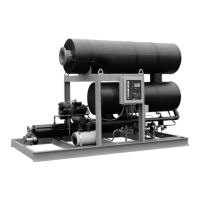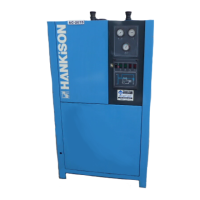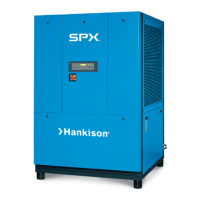18
E
N
G
L
I
S
H
1. Power off Check main switch, fuses and wiring.
2. Master off/on switch Pull master off/on switch out.
3. Loose electrical connections or faulty wiring Check wiring and tighten connections.
4. Hot gas or liquid line solenoid valve closed Check for burned out holding coil.
5. Unit in STANDBY mode Turn switch to auto.
6. Compressor motor burned out Replace, if defective.
1. Leaking liquid line solenoid Remove obstruction or replace valve.
2. Leaking hot gas valve Replace valve.
3. Leaking valves in compressor Replace valve plate assembly.
1. Water-cooled units - Excessive water flow Adjust water regulating valve or, on 3" and
through condenser 4" water valve clean power head.
2. Air-cooled units-Fan switch not cycling properly
.
Check/replace fan switch.
3. Leaky compressor suction valve Examine valve discs & seats; replace if necessary.
4. Worn piston rings Replace if worn.
Compressor stopped because
of high head pressure
"HIGH REFRIG PRESS"
Compressor stopped because
low suction pressure
"LOW REFRIG PRESS"
Compressor stopped because
of low oil pressure
"LOW OIL PRESSURE"
Compressor stopped because
solid state motor protector
open
"SSMP"
Compressor stopped because
motor starter protector open
"MTR STARTER"
High air temperature leaving
the evaporator
"HIGH EVAP AIR TEMP"
Compressor will not start
Compressor cycles
intermittently in standby mode
Low refrigerant head pressure
1. Faulty high pressure transducer (PT200) Check pressure reading, calibrate/
replace. (Consult factory for calibration)
2. Refrigerant overcharge Reclaim excess refrigerant.
3. Air in refrigeration system Check for leaks and recharge unit.
Properly dispose of old refrigerant.
4. Air load on unit during start-up Take air load off unit during start-up.
5. Water-cooled units - Insufficient water flow
through condenser
(1) Water regulating valve not adjusted Adjust water regulating valve.
(2) Dirty water strainer Clean water strainer.
(3) Water lines too small Increase water main size to condenser.
(4) Discharge shutoff valve not fully open Open valve.
(5) Condenser water pump off Check and start.
(6) Plugged or scaled condenser tubes Clean tubes.
(7) Low water pressure differential Check. Should be a 40 psi differential.
(8) Inlet water temperature too high Use cooler water.
6. Air-cooled units
a) Condenser dirty Clean condenser.
b) Fans not operating Check for power. Check fan switch pressure
set point. Fan motor faulty repair or replace.
1. Low refrigerant charge Check for leaks and repair; add refrigerant.
2. Suction pressure setting incorrect Adjust hot gas by-pass valve.
3. Incorrect low pressure switch setting Check technical data for proper setting.
4. Hot gas valve sticking Check and repair.
5. Faulty low-pressure transducer. (PT100) Check pressure reading, Calibrate/
replace. (Consult factory for calibration)
6. Defective CPU or component module Check/replace.
7. Refrigerant compressor not unloading Check unloader mechanism/replace.
properly (20 HP and up)
TROUBLE SHOOTING GUIDE
SYMPTOM / FAULT POSSIBLE CAUSES CORRECTIVE ACTION
1. Low oil charge Add oil.
2. Clogged oil suction strainer Clean.
3. Worn oil pump Replace pump assembly.
4. Worn compressor bearings Replace compressor.
5. See: Cold Compressor
6. Suction line filter restricted Check for pressure drop across filter/
replace elements.
7. Air load supplied to unit during start-up. Take air load off dryer to start.
8. 7-1/2 - 15 HP units - compressor could See: SSMP 1, 2, and 3
have tripped on internal overload.
1. Unit overload Check inlet flow, pressure and temperature
and verify if within design conditions.
2. Insufficient cooling Check refrigeration system temperatures.
3. Faulty temperature switch Measure air temperature.
4. No air flow through dryer Check inlet flow
1. Low voltage Check power supply.
2. Line imbalance Check power supply.
3. Excessive return gas temperature. Check liquid injection valve and refrigerant charge.
4. Defective SSMP module Check/replace.
5. Defecitve motor sensor Refer to Section 3.3 of Manual. Check sensors at
room temp. Should be between 500-10,000 ohms.
1. Low voltage Check power supply.
2. Line imbalance Check power supply.
3. Compressor motor drawing excess current Check motor winding resistance.

